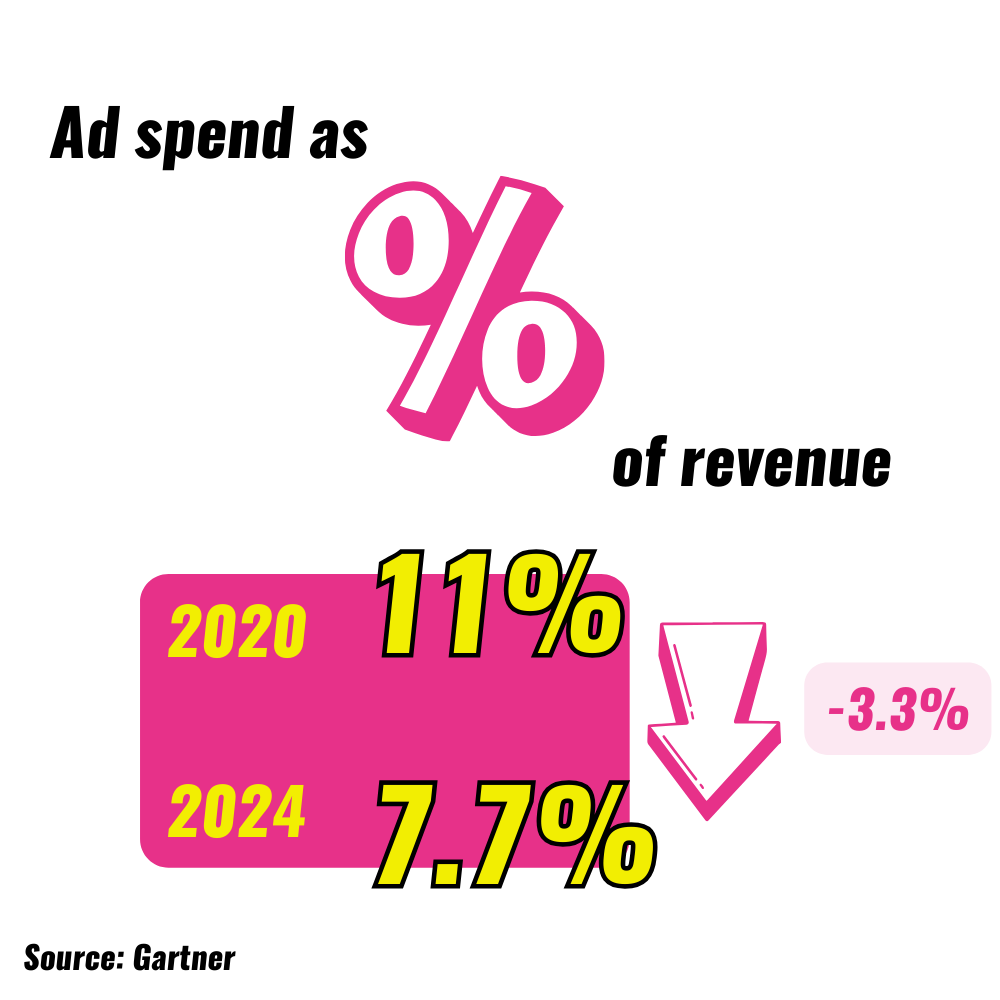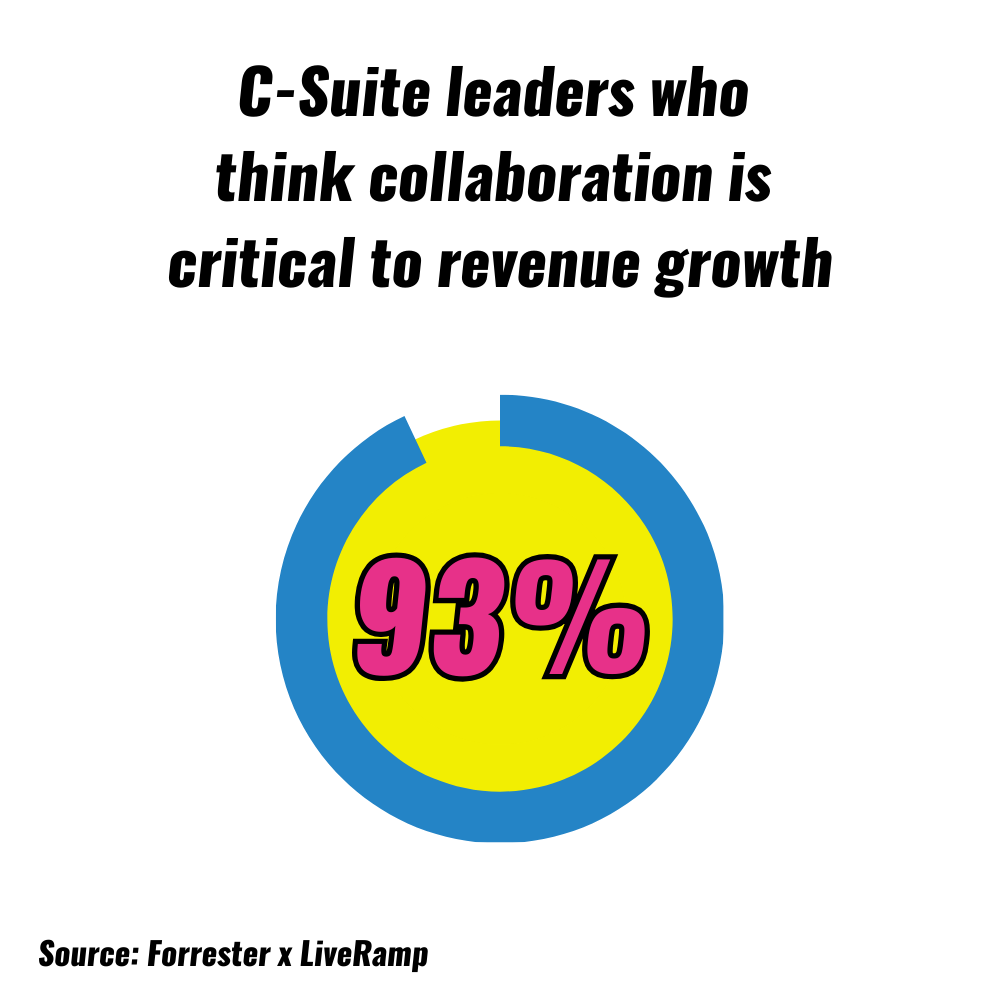The 2025 guide to first-party data: 6 trends marketers need to know
10 February 2025

What a year 2024 was in the world of data. Google made its surprise about-turn on third-party cookies (already half buried, they now get to live on after all), while the meteoric rise of AI and machine learning put data quality under renewed scrutiny. Meanwhile, data collaboration became increasingly central to organisational strategies, with retail media networks leading the charge.
The question is, what’s next?
Right now, marketers are feeling the squeeze. UK marketing budgets saw modest growth in the final quarter of 2024, after flatlining the previous quarter, and global spend shrank to just 7.7% of company revenue – a far cry from the 11% we saw in 2020.
That’s 30% less cash to make magic happen, forcing marketers to sweat every penny to prove their worth in the boardroom.

Against this backdrop, first-party data is the most powerful weapon in a marketer’s arsenal. It’s accurate, reliable, and bang-on relevant. It helps brands to truly understand their consumers, improve their targeting, supercharge decision-making, and better measure the impact of marketing investments - all while keeping privacy front and centre.
Marketers just need to make the most of it.
So, as we launch into 2025, what’s next for first-party data? With help from our expert partner LiveRamp, we’re diving into the six trends that will shape the landscape so you can seize the opportunities heading your way.

Already feel bamboozled? Don’t worry - you’re not alone. Data is a topic that baffles even the most experienced marketers. Here’s your crash course in the most important definitions:
First-party data: The gold standard - data collected straight from your customers with explicit consent, whether through interactions on the web, apps, social media, emails, loyalty schemes, or even in-store transactions. It's considered the most reliable data type because it comes straight from your audience, offering insights into customer preferences so you can develop tailored marketing strategies and campaigns.
But its usefulness diminishes when spread across disconnected systems, like marketing platforms, customer relationship management tools (CRMs), and point of sale (POS) systems.
If your customer has multiple email addresses or has changed her name, her data might exist in various different places within your systems. Without integrating this information securely and accurately, you risk delivering a fragmented customer experience.
Most companies have first-party data, but some more than others. Major retailers like Tesco and Boots have built masses of it over the years through their Clubcard and Advantage Card loyalty schemes and new retail media networks.
Others, like consumer packaged goods (CPG) brands, are unlikely to have direct customer relationships, and therefore rely on external data intelligence for precision ad targeting, lookalike modelling, and measurement.
Second-party data: Someone else's first-party data, shared with you as a trusted partner - with the customer’s consent, of course. For instance, a fashion retailer might enter into a second-party data partnership with a popular online magazine so it can better target its advertising product recommendations.
Third-party data: Collected on other sites, platforms, or offline by - you guessed it - a third party.
Think Acxiom, Nielsen, and OnAudience. The data is usually broad, anonymous, and used extensively by companies to better understand and target audiences. It’s particularly great for demographic, contextual, or behavioural targeting.
Zero-party data: A term invented by Forrester Research, describing information that a customer willingly and proactively shares with you through social media, quizzes and surveys, customer service chatbots etc. It’s usually highly valuable because it comes straight from the source and is explicit in nature.
Data collaboration: The act of gathering and connecting data from various sources to unlock combined data insights. Chances are you or your company have already participated in data collaboration through platforms like Google Ads Data Hub, Facebook Advanced Analytics, and Amazon Marketing Cloud, where data is shared and analysed within controlled environments.
With that out of the way, let’s get into the trends.

Retail media networks - platforms retailers use to sell ad space across their digital properties, using their first-party data to target audiences - are flourishing.
In the UK alone, retail media spend, excluding Amazon, is set to top £1bn in 2025. Add the ecommerce giant back in, and we’re looking at a market north of £7bn by 2028. That’s almost on par with social display ads.
But there’s a catch: fragmentation. As of last year, there were over 200 networks worldwide.
As the landscape grows, it’s becoming an ever more messy patchwork of inventory, metrics, and attribution standards. These inconsistencies make it difficult for brands to allocate budgets effectively.
So, as retail media networks become increasingly sophisticated in their offerings, standardisation is moving from a ‘nice to have’ to a ‘need to have’, so is set to become a strategic priority in 2025.
“With brands having numerous options for allocating their ad budgets, standardisation will emerge as a key differentiator,” says Hugh Stevens, UK Managing Director at LiveRamp.
“Adding standardised templates to a tech stack simplifies legal processes, streamlines metrics like reach and frequency, and ensures analytics deliver immediate value - all without compromising privacy or flexibility.”
The networks that embrace this shift will become the go-to partners for marketers navigating an increasingly fractured landscape.

While retail media networks continue to mature and standardise, a new evolution is set to steal the spotlight: commerce media.
This umbrella term encompasses not only retail media, but also ad platforms within sectors like travel, hospitality, gaming, and finance. Banks, payment providers, airlines, and hotels also boast deep customer relationships and rich first-party data, making them valuable players in this space.
Commerce media offers access to consumer touchpoints beyond retail - from booking holidays to managing finances.
Leading the charge are networks like Uber Ads -which hit $1bn in revenue last year, six months ahead of schedule - PayPal Ads, launched in October, and United Airlines’ Kinective Media, unveiled mid-2024.
LiveRamp predicts a surge in brands leveraging the wealth of first-party data across industries beyond retail, fuelling commerce media’s rapid growth in 2025. Travel-focused commerce media alone is forecast to hit $2.96bn in ad spend this year.
“Travel and hospitality companies that successfully unlock unique consumer insights from their data for advertising partners can tap into new, high-margin revenue streams across their owned and operated properties,” says Tara Franceschini, High Growth Vertical Specialist at LiveRamp.
“Brands that embrace this data for enrichment stand to drive increased sales and measurable impact.”
The lesson? Broaden your horizons and tap into commerce media’s untapped potential across an array of consumer experiences.

The cloud is becoming the backbone of modern advertising, and in 2025, advertisers will hit a tipping point – or ‘critical mass’ – in their reliance on it.
This means more businesses will fully integrate cloud-based systems into their operations, driving greater standardisation and transparency across the industry.
Why does this matter? Right now, brands often face fragmentation in their data and technology, with systems that don’t talk to each other. That’s a nightmare when it comes to managing campaigns, measuring success, and collaborating effectively.
Enter interoperable systems like data clean rooms - secure spaces where advertisers can share and analyse data without compromising privacy. These tools allow brands to bring together their fragmented infrastructures, creating a seamless flow of information.
While the US has led the charge on cloud adoption, the UK has lagged behind. But 2025 will see UK advertisers step up their game, recognising the cloud’s potential to unify systems, enhance collaboration, and stay competitive on a global scale.
It’s time to embrace the cloud or risk being left in the dust.

Data collaboration has become essential for accelerating business growth, helping organisations unlock key insights from across retailer, publisher, and brand partner data.
In fact, according to a recent Forrester x LiveRamp study, 93% of C-suite leaders believe collaboration is critical for driving revenue growth.
But to make it work, you need an airtight commitment to privacy. That’s where clean rooms - privacy-optimised environments for secure data sharing - come in, and why they are set to deliver transformative outcomes in 2025.

For brands needing to measure omnichannel campaigns across multiple media platforms, or publishers looking to boost ROI for their top advertisers, clean rooms with standardised insights make collaboration faster, easier, and more scalable.
These tools ensure businesses can work together without compromising data security, enabling them to gain deeper audience understanding and drive stronger results.
As Sam Taylor, Marketing Director at Direct Line Group, said during a recent LiveRamp webinar: “If you’re a CMO and haven’t started this journey yet, start now. It’s not easy, but it’s critical… and it’s a necessary journey for long-term growth that will deliver a strategic competitive advantage.”

More than ever before, marketers are expected to be a jack-of-all-trades and measure performance across TV, CTV, social media, digital, and programmatic all at once.
But with media measurement and attribution so fragmented, understanding what’s driving success can feel beyond daunting.
In 2025, brands will have the opportunity to get a clearer picture of their media performance and make sharper advertising decisions through true cross-screen measurement.
By tapping into first-party data and collaborative tools, marketers can connect the dots across their entire media mix - meaning better visibility, smarter decisions, and more effective campaigns.
But to make the most of these advancements, brands need to put identity resolution front and centre. The clock is ticking for third-party cookies - Google may have delayed the inevitable, but with other browsers already making the move, marketers need to act now.
Enterprise identity solutions offer a way forward by securely linking customer data across channels, ensuring consistent recognition and measurement while maintaining privacy.
With a rock-solid identity strategy powering their data, brands can have a more accurate and connected customer view that sets the business up effectively for advancements in areas like cross-screen measurement.
The tech is evolving, and it’s moving fast. Those who embrace identity resolution early will gain a serious edge, turning chaos into clarity and complexity into opportunity.

Let’s be real - AI is no longer just a buzzword. It’s actively transforming how marketing works.
Whether it’s Perplexity, OpenAI, or marketing-specific tools like Writer or 6sense, AI is already reshaping how people produce and consume content, and 2025 will see it take centre stage in marketing strategies.
Search is already undergoing a major shift, with tools like Google’s AI Overview changing the game. This year will therefore see marketers reimagining their SEO strategies to ensure content is optimised for inclusion and citation in these AI summaries. We can also expect more AI-assisted paid search, with search engine Perplexity among those already offering such tools.

Elsewhere, AI chatbots such as Drift have become one of the fastest-growing channels, and LiveRamp encourages forward-thinking marketers to start experimenting now.
Testing campaigns on platforms powered by AI will help brands understand how to engage audiences in this space, refine messaging, and optimise performance.
With AI tools becoming more integrated into everyday life, brands that act early can gain a competitive edge, ensuring they’re ready for a future where AI plays a central role in shaping consumer behaviour and driving measurable outcomes.
In 2025, staying ahead means embracing AI, not waiting on the sidelines.
A first-party data strategy isn’t just a nice-to-have - it’s the essential hygiene factor for marketers heading into 2025.
As budgets tighten and the digital ecosystem grows increasingly complex, first-party data offers marketers a much-needed edge, enabling them to deliver precise targeting, improve campaign measurement, and power decision-making – all while respecting consumer privacy.
Marketers who embrace these changes, invest in clean rooms, and prioritise collaboration will be the ones leading the pack. So, what are you waiting for?

LiveRamp is the data collaboration platform of choice for the world’s most innovative companies.
A groundbreaking leader in consumer privacy, data ethics, and foundational identity, LiveRamp is setting the new standard for building a connected customer view with unmatched clarity and context while protecting precious brand and consumer trust.
LiveRamp offers complete flexibility to collaborate wherever data lives to support the widest range of data collaboration use cases - within organisations, between brands, and across its premier global network of top-quality partners.
Want to hear more? Contact LiveRamp here.

